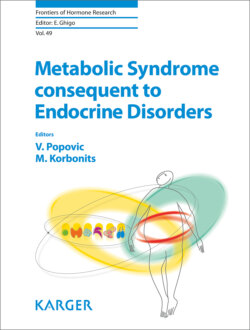Читать книгу Metabolic Syndrome Consequent to Endocrine Disorders - Группа авторов - Страница 14
Prevalence of MetS in Patients with Hypopituitarism
ОглавлениеIn 50 Dutch hypopituitary patients with adult-onset GHD, prevalence of MetS was increased by more than 2-fold compared with the general population (38 vs. 15.7%). Hypertriglyceridemia (46 vs. 18%), hypertension (66 vs. 35.5%), and abdominal obesity (38 vs. 23.4%) were significantly more prevalent in patients with hypopituitarism than that in the general population [2]. Prevalence of MetS did not change after 2 and 5 years of treatment with GH [2].
Study of adult hypopituitary GHD patients from Hypopituitary Control and Complications Study (HypoCCS) data base (n = 2,531) reported prevalence of MetS in 42.3% (51.8% in USA and 28.6% in Europe) of patients [4]. The difference in MetS prevalence between USA and Europe was due to obesity prevalence (75% of USA patients were overweight or obese) and lower proportion of younger patients with childhood onset disease [4]. Increased MetS risk was observed for age >40 years, female sex, and adult onset of the disease [4]. In GH treated patients MetS prevalence was not changed after 3 years [4].
KIMS (Pfizer International Metabolic Database) database analysis in 2,589 adult patients with hypopituitarism and GHD showed that approximately 71% of patients had elevated total and low-density lipoprotein (LDL) cholesterol levels, 49% were below desired target value for HDL cholesterol, while 55% had higher triglycerides [29]. Obesity was prominent (32% had a BMI >30) [26]. Waist circumference was above the target value in 46% and BP elevated in 26% of patients [26]. Statistically significant reductions in total cholesterol, waist-to-hip ratio, and fat tissue by dual X-ray absorptiometry, with a corresponding increase in lean body mass, were observed after 1 and 2 years of GH replacement [26].
The study from the USA analyzed prevalence of the MetS in elderly adult, predominantly male hypopituitary patients (n = 141, mean age 66 years) [3]. The study was controlled for obesity to see if endocrine deficiency per se is associated with metabolic consequences. Hypopituitary patients exhibited significantly higher prevalence of hypertension (88 vs. 78%), hypertriglyceridemia (80 vs. 70%), and MetS (90 vs. 71%) [3]. Results of this study suggested that hypopituitarism per se is associated with MetS independent of BMI.
More recent study on the prevalence of MetS in patients with hypopituitarism from KIMS database (Pfizer International Metabolic Database) reported rates of 43.1% [5]. MetS prevalence was related to age, BMI, waist circumference, GHD duration, and etiology of hypopituitarism [5]. Highest prevalence was reported in patients with craniopharyngeomas 45.9%, pituitary adenomas 44.7%, and idiopathic/congenital GHD 42.4% [5]. Prevalence of diabetes mellitus, cardiovascular, and cerebrovascular morbidity was higher in the MetS group and increased significantly with the escalating number of components of the MetS [5].
Study which followed 98 GHD patients on long-term GH replacement therapy (GHRT), for at least 10 years, demonstrated ongoing beneficial effects of the GHRT on lipid profile in the presence of increase in anthropometric parameters such as BMI, waist circumference, and systolic BP [7]. As a consequence, prevalence of the MetS increased significantly after 10 years of GHRT [7]. It was concluded that the increase in MetS prevalence, from 32.7 to 46.9% after 5 years of GHRT and to 57.1% after 10 years of GHRT, was higher than expected as a consequence of aging alone [7].
In contrast to the previous study, in Nordinet International outcome study, 36% of patients, with data on the MetS at baseline, fulfilled the criteria for MetS, while 40% fulfilled those criteria at 4 years of GH replacement, suggesting no significant change in the prevalence of MetS during treatment with GH [16].
